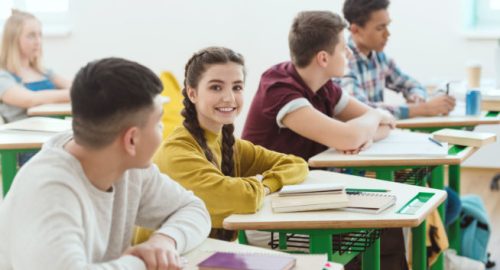With over 35,000 K-12 partner schools, Raptor is fortunate to have thousands of insightful conversations with schools across the country about what is occurring within their buildings and communities. We recently had a panel discussion with two Raptor partner districts to talk about school safety now and after the pandemic. The panel included:
- Marti Neahring: Director, Student Services at West Aurora School District
- Steven Chatterton: Director, Safety and Security at Greece Central School District
- Alix Miller: Manager, Customer Success at Raptor Technologies
Below are highlights from the panel discussion. You can listen to the full conversation here.
Panel Discussion
How has COVID-19 changed safety at your schools?
Marti: We knew we had to support students remotely, so we focused on providing some safety measures for students at home. We launched our Stay Safe at Home 129 initiative that provided opportunities for our students and their families to learn how to be prepared for incidents at home, like fires or severe weather events. We have also minimized building access, only have very essential meetings in person, and have closed our outdoor spaces like our soccer fields and playgrounds.
Steve: We limited access to our buildings as well. We typically have open facilities so outside organizations can use our classrooms. When the school day is over, we now lock the doors so our custodial team can have time to sanitize everything.
Do you have screening protocols for people who do come to campus?
Steve: We had to figure out how to screen non-employees, district employees, or substitutes that are not in our email database. We use Raptor to screen these individuals, and we have incorporated screening questions into our visitor management check in process. We screen everyone who comes into the building.
Marti: Staff and students guardians receive a daily email and we ask them to certify that they are symptom-free, haven’t been in close contact with anyone that has COVID-19, or have traveled internationally. The essential visitors we have coming into the building have to be screened with Raptor as well.
Alix: Raptor released our health screening functionality over the summer. We recognized that schools would need a method of asking these COVID-19 health questions and tracking their answers. As of December, our health screening is being used in over 4,000 schools and has screened students over one million times, staff over 471K times, and visitors over 426K times since July. If someones answer to a question indicates a risk, the system notifies the correct people so they can make an appropriate decision.
How has your school been conducting drills and other safety fundamentals during COVID-19?
Marti: It’s important that we do drills correctly. The drills must reinforce the things we’ve been teaching students before the pandemic. We created videos so that teachers can show their students what a drill or fire evacuation should look like. We’ve also given them the opportunity to physically walk their students through that in class. Drills have weighed a lot on my mind because we need to make sure we are keeping the kids safe from COVID-19 while we are keeping them safe from other threats.
Steve: New York did not lower the drill requirements, but they did allow for modifications to the procedures. For example, instead of evacuating the entire school to the front parking lot, we will have some students in the front parking lot and others in the back of the school. We also worked with the local fire departments to create acceptable plans. For lockdowns, we still go through the whole scenario, but we now simulate the lockdown and talk the kids through it instead of having them physically go into lockdown and hide. There is a lot of research out there that shows one of the most dangerous times in the school regarding violent events and active shooters is after a long break. When we come back to school after COVID-19, its going to be after a long break. We must remember what research shows and that there is a possibility we will see dangerous school events again.
What are things you are doing to prepare for the possibility of a tragic event?
Steve: Everything we do is districtwide, but we’ve had a lot of changes since COVID-19 with teachers retiring and new teachers being hired. We’re going to go into all our staff meetings and make sure that everyone knows our safety procedures and that these procedures are updated. We will do some tabletop drills and scenarios and get everyone back on the same page after this long break.
Marti: We want everyone to speak the same language throughout the entire district. School safety is a big agenda item in all the meetings that I have. We’re always talking about the research and the likelihood of tragedies happening after long breaks. We’ve encouraged our administrators to have these safety conversations in their staff meetings, so safety is part of a continual conversation.
Has your school changed your volunteer policies?
Steve: We updated our volunteer procedure during COVID-19. We originally had volunteers fill out one application that went through HR. We would call the listed references and make sure the applicant was a good fit. We had an internal auditor look at our process from building to building and we found that each building may have its own volunteer list. A lot of those lists weren’t updated. A volunteer list that was created five years ago may still show someone as an approved volunteer when they are not. We decided to start fresh and use Raptor Volunteer Management. Now applicants apply through Raptor and must pass the background check. We also identified a volunteer coordinator at each school. We don’t have volunteers right now, but we have an updated process once we start having volunteers on campus and events again.
Alix: Volunteerism has always had an in-person component, and when we think of volunteers, we tend to think of them in the building. One of our largest partner districts pivoted their entire volunteer community to virtual engagement when they recognized their need for additional support resources. These resources help with building relationships with students, being reading buddies, and tutoring. There was a lot of emotional, educational, and behavioral concerns that the district wanted to stay in front of, so they use Raptor Volunteer Management to connect with their approved volunteers and list available opportunities. Looking forward, we dont really know what the new standards and requirements are going to be to approve volunteers. The background check is absolutely best practice, but Im curious what other standard questions will be part of the application. It can be cumbersome to track all the volunteers information and answers to these questions without a solution that can help you facilitate the application and streamline that process.
How do you see the pandemic impacting your schools as you look at safety in the future?
Marti: We are standardizing and trying to have very clear, plain language in our procedures so that everyone understands what is going on. For example, we have lockdown and soft lockdown.If we announce going into soft lockdown over our PA system, but someone misses the word soft, they won’t know how to respond. We want to make sure that everyone can make the appropriate decisions based on the situation at hand.
Steve: New York has standardized language that is adopted by the entire state. But sometimes when we go to other districts, we find that some schools are not using that language. The five terms are: shelter in place, hold in place, evacuation, lockdown, and lockout. Years ago, we had buildings using color codes, like code red or code blue. When I came to the district from law enforcement, I recognized that the police department would not understand what code red or code blue means. Having the standardized language throughout New York has helped immensely.
In regard to your emergency operations plan (EOP), did you have procedures in place for a pandemic already?
Steve: We had a minor pandemic plan in our districtwide EOP, but it wasn’t in our building-level plan. New York just expanded pandemic planning and requires us to have it in our plan by April 1. In response to COVID-19, we followed our incident command system. We met as a group and discussed how we can keep buildings open and how we can teach our students and deliver their meals and resources when the buildings are closed.
What were your reasons for implementing a visitor management system and what benefits have you seen using it?
Steve: We were still using paper logbooks when I joined the district. We couldn’t read some peoples names or tell who was in the building. We implemented Raptor Visitor Management districtwide so we can be consistent. We can now prove who was in the building and when. We also developed a policy and procedure for our visitors.
Alix: When we talk about visitor management, our focus has been on the screening aspect. We screen for sex offender status and check custom databases to see if the individual has any restrictions before we grant them access to the building. An added benefit of Raptor Visitor Management is knowing who is in the building and when. Before the pandemic, this wasn’t necessarily the leading factor people discussed, but it is now considered a core fundamental to know exactly who is in the building at any given moment. Searching a paper logbook or Google form to pull visitor information is not feasible. Contact tracing requires having that information readily available and ensuring that you can provide districtwide visibility.
Do you have any big lessons learned from this past year that you see yourself implementing next year?
Steve: The ability of these schools and districts to adapt and overcome has been amazing. Looking forward, we have to get back to what we were doing and hope for some normalcy. We also have to realize that there are going to be some changes based on the pandemic. We must be prepared for what is going to happen when everyone comes back into the buildings. We’ll have kids coming back into the school who may not have been fully engaged at home and who may be waking up at 11 in the morning instead of 6 in the morning. It’s going to be a challenge moving forward, especially since we still do not know when we will return back to school.
Marti: We must embrace the new normal and continue to look at things a little bit differently. We have learned a lot about communication and how important it is to our staff, students, and community. We need to put our lessons learned from this crisis to good use and keep planning.
Protecting Your Schools Now and After the Pandemic
Schools have shown incredible dedication, flexibility, and innovation during the COVID-19 pandemic. As students return to the classroom, schools must continue COVID-19 response while supporting daily operations and focusing on student and staff safety. Leveraging a trusted school safety platform can help you respond to COVID-19 and will continue to be a critical component to your school security approach long after the pandemic ends.
The Raptor K-12 integrated school safety platform includes Raptor Visitor Management, Raptor Emergency Management, and Raptor Volunteer Management. These solutions empower schools to screen and track visitors, successfully respond to any emergency, manage volunteers, and confidently respond to COVID-19. To learn more about Raptor, contact us today to set up a personalized demo.





